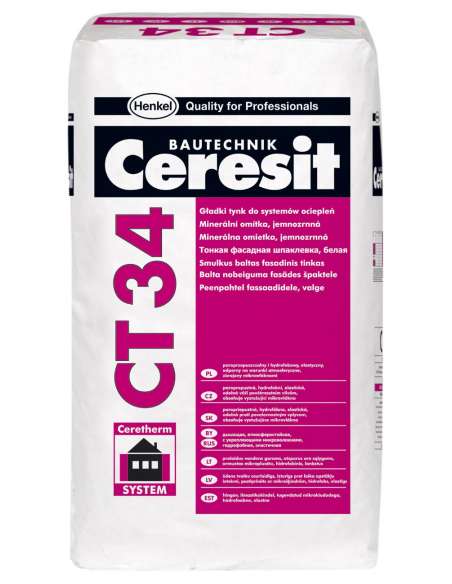- Flexible
- Vapour permeable
- Hydrophobic
- Reinforced microfibres
- Resistant to weather conditions
- Easy to use
CT 137 conveys a “stone” texture upon floating. It can be used as a finishing coat in Ceresit Ceretherm thermal insulation systems with the use of polystyrene boards or Ceresit Ceretherm Wool, with the use of facade mineral wool boards. It is also suitable for use on traditional plasters, inside and outside of buildings. Available in an economical version for painting. Hydrophobic and vapor permeable at the same time.
CT 137 can be applied to carrying substrates that are smooth, dry and clean (free from any substances decreasing adhesion such as grease, bitumen, dust):
– concrete, cement plasters and lime-cement plasters (age above 28 days, moisture ≤ 4%), primed with the paint Ceresit CT 16,
– armoured layers made of the Ceresit CT 85 or CT 190 mortar (age above 3 days), primed with the paint CT 16,
– gypsum substrates (only inside the buildings) with moisture below 1%, firstly primed with Ceresit CT 17, and then with the paint CT 16,
– gypsum cardboards, gypsum-fibre boards (only inside the buildings), fixed according to the recommendations of the board manufacturers, firstly primed with CT 17, and then with the paint CT 16,
– strong paint coats with good adhesion to the substrate (only inside the buildings), primed with the paint CT 16.
Uneven and damaged substrates should be first repaired. In case of traditional plasters and concrete substrates Ceresit CT 29 can be used. The existing dirt, layers of low strength, as well as lime paint and adhesive coatings should be removed. Absorptive substrates should be primed with the agent Ceresit CT 17, and then painted with Ceresit CT 16 after minimum 4 hours. The layer of the plaster CT 137 is recommended to be applied the next day after the substrate is primed.
The whole content of the packaging should be poured into the measured amount of clean, cool water and mixed by means of the drill with a mixer until the homogenous mass without lumps is obtained. Neither rusty containers nor tools can be used. The consistency should be adjusted to the application conditions. The same consistency of the material should be maintained by remixing the plaster with the drill and not by adding water during the application of CT 137. Plaster should be evenly applied to the substrate at the thickness of the grain by means of a steel long float held at the angle. Then, it should be given homogenous structure with round movements by means of a plastic long float flatly held to achieve the appearance of densely laid out aggregate grains structure. Do not sprinkle plaster with water! Work should be done on one surface without breaks, dosing the same amount of water. If there is a need to stop working, the self-adhesive tape should be applied along the previously fixed line. Then plaster should be applied, structure formed, and tape torn off with the plaster remaining on it. After a break, the application should be continued from the fixed place (the edge of the previously applied plaster can be protected with self-adhesive tape).
Tools and fresh plaster stains should be washed with water, and the hardened plaster remains can be mechanically removed. Plaster renovation should be done by painting with Ceresit CT 42 and CT 44 acrylic paints, Ceresit CT 54 silicate paint as well as Ceresit CT 48 silicone paint.
- Model
- CT34
- Usage/Coverage
- approx. 1.5kg/sqm/1mm
- Size
- 25 kg
- Unit
- bag


